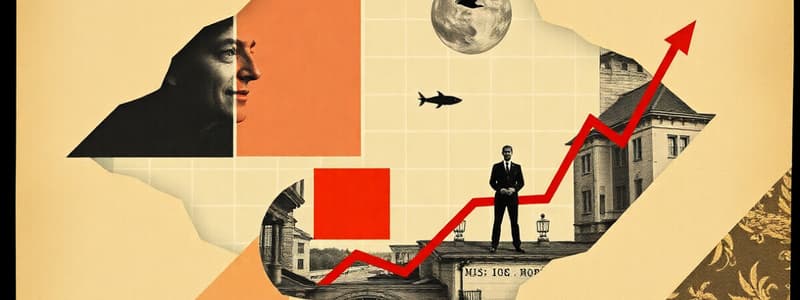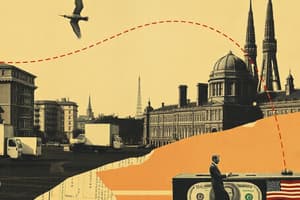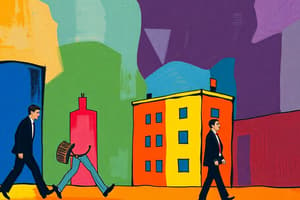Podcast
Questions and Answers
Which type of unemployment is caused by a mismatch between the skills of workers and the demands of the labor market?
Which type of unemployment is caused by a mismatch between the skills of workers and the demands of the labor market?
- Cyclical Unemployment
- Structural Unemployment (correct)
- Natural Unemployment
- Frictional Unemployment
What is the term used for the difference between the potential GDP and actual GDP?
What is the term used for the difference between the potential GDP and actual GDP?
- Output Gap
- Unemployment Gap
- Economic Gap
- GDP Gap (correct)
Which of the following contributes to a decrease in frictional unemployment?
Which of the following contributes to a decrease in frictional unemployment?
- Declining technological advancements
- Improved access to job seeking information (correct)
- Increased government regulations
- Increased labor market rigidity
What is a negative GDP gap associated with?
What is a negative GDP gap associated with?
Which type of unemployment is most likely to occur during a recession?
Which type of unemployment is most likely to occur during a recession?
According to Okun's Law, what is the estimated impact on GDP for every 1% increase in the unemployment rate above the natural rate?
According to Okun's Law, what is the estimated impact on GDP for every 1% increase in the unemployment rate above the natural rate?
Which of the following factors can influence the natural rate of unemployment?
Which of the following factors can influence the natural rate of unemployment?
What is a potential negative consequence of long-term unemployment?
What is a potential negative consequence of long-term unemployment?
Which demographic group is generally considered more vulnerable to unemployment during economic downturns?
Which demographic group is generally considered more vulnerable to unemployment during economic downturns?
What is one of the key factors that policy makers can focus on to address the issue of unemployment?
What is one of the key factors that policy makers can focus on to address the issue of unemployment?
What typically happens in Malaysia's economy every 11-12 years?
What typically happens in Malaysia's economy every 11-12 years?
Which type of unemployment occurs primarily during economic downturns?
Which type of unemployment occurs primarily during economic downturns?
Demand-pull inflation is characterized by what economic condition?
Demand-pull inflation is characterized by what economic condition?
What impact does structural unemployment have on the workforce?
What impact does structural unemployment have on the workforce?
Which of the following is an example of structural transformation?
Which of the following is an example of structural transformation?
What leads to frictional unemployment?
What leads to frictional unemployment?
What is a significant consequence of technological advancements on employment?
What is a significant consequence of technological advancements on employment?
Which statement is true regarding the structure of Malaysia's economy?
Which statement is true regarding the structure of Malaysia's economy?
Flashcards
Business Cycle
Business Cycle
The fluctuations in economic activity, including periods of expansion and recession.
Demand-Pull Inflation
Demand-Pull Inflation
Inflation caused by too much demand for goods when supply can't keep up.
Cyclical Unemployment
Cyclical Unemployment
Unemployment resulting from economic recessions or downturns.
Frictional Unemployment
Frictional Unemployment
Signup and view all the flashcards
Structural Unemployment
Structural Unemployment
Signup and view all the flashcards
Structural Transformation
Structural Transformation
Signup and view all the flashcards
Job Obsolescence
Job Obsolescence
Signup and view all the flashcards
Emerging Industries
Emerging Industries
Signup and view all the flashcards
Full Employment
Full Employment
Signup and view all the flashcards
Natural Rate of Unemployment
Natural Rate of Unemployment
Signup and view all the flashcards
GDP Gap
GDP Gap
Signup and view all the flashcards
Okun's Law
Okun's Law
Signup and view all the flashcards
Loss of Skills
Loss of Skills
Signup and view all the flashcards
Negative GDP Gap
Negative GDP Gap
Signup and view all the flashcards
Factors Affecting Unemployment Rates
Factors Affecting Unemployment Rates
Signup and view all the flashcards
Study Notes
The Business Cycle
- Economic activity fluctuates between periods of expansion (growth) and recession (contraction).
- Malaysia has experienced recessions in the mid-1980s, 1997-98, 2008-2009, and 2020, with a typical pattern of one every 11-12 years.
- Recessions can make employment difficult for recent graduates.
Problems of the Business Cycle
- Rapid economic growth can lead to demand-pull inflation, where excessive spending outpaces available goods.
- Recessions increase unemployment, particularly cyclical unemployment, affecting various sectors.
Unemployment
- Unemployment types include frictional, structural, and cyclical.
- Frictional unemployment is normal job transitions.
- Structural unemployment arises from economic shifts, like the transition from agriculture to manufacturing and services in Malaysia.
Economic Transformation and Unemployment
- Structural transformation causes job shifts between sectors due to technology or economic shifts.
- Examples of shifts include: agriculture declining due to modernization and land use changes; technological advancements replacing traditional jobs with new ones; mobile phone industry transitions impacting companies like Nokia and Ericsson.
- Structural unemployment involves job obsolescence requiring skill adaptation.
- New industries create new job opportunities.
- Cyclical unemployment results from economic downturns, affecting many industries.
Full Employment and the Natural Rate of Unemployment
- Full employment means all resources are utilized, reaching the natural rate of unemployment.
- The natural rate comprises of frictional and structural unemployment.
- Frictional unemployment happens during job transitions.
- Structural unemployment arises from changes in the economy requiring skill adaptation.
- Zero unemployment is not realistically attainable.
- Factors like labor market flexibility and technology influence the natural rate of unemployment, varying between countries.
Economic Costs of Unemployment
- The GDP gap represents the difference between potential GDP (with full employment) and actual GDP.
- A negative GDP gap occurs when unemployment surpasses the natural rate, meaning less output.
- A positive GDP gap happens when unemployment is below the natural rate, meaning the economy exceeds its potential output.
- Okun's Law estimates the GDP loss from unemployment: a 1% increase above the natural rate results a 2% loss in potential GDP.
Social Costs of Unemployment
- Unemployment can reduce skills over time, affecting future employment prospects.
- Unemployment can demoralize individuals, reducing motivation.
- Unemployment can increase family stress, potentially leading to family breakdown and divorce.
- Unemployment can lead to poverty.
- Unemployment can cause societal unrest and tensions between different groups.
Factors Affecting Unemployment Rates
- Younger individuals are more affected by unemployment during economic downturns.
- Lower-skilled jobs are more susceptible to recessions than higher-skilled ones.
- Social inequalities can affect unemployment rates for certain ethnic groups.
- Men tend to be more affected than women during economic downturns.
Conclusion
- Understanding unemployment and its consequences is crucial for policymakers and individuals.
- Solutions involve policies to support a flexible labor market, economic growth, worker training, and vulnerable groups.
Studying That Suits You
Use AI to generate personalized quizzes and flashcards to suit your learning preferences.




